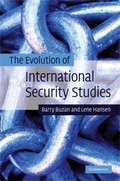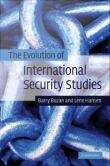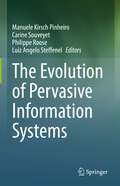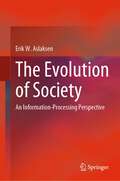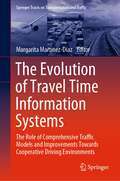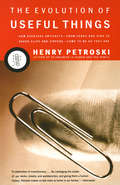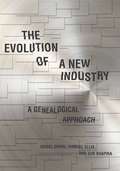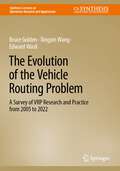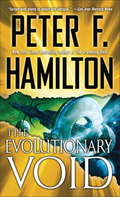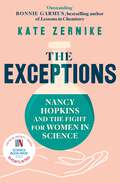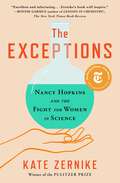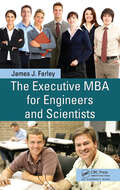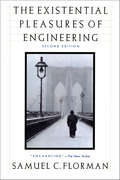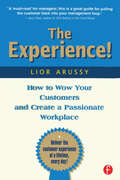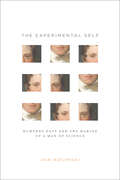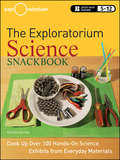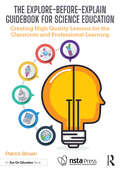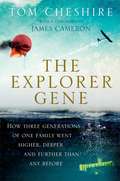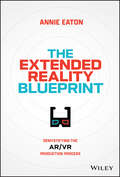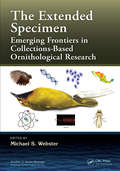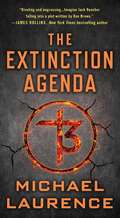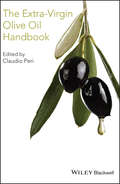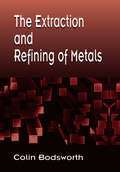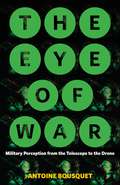- Table View
- List View
The Evolution of International Security Studies
by Barry Buzan Lene HansenInternational Security Studies (ISS) has changed and diversified in many ways since 1945. This book provides the first intellectual history of the development of the subject in that period. It explains how ISS evolved from an initial concern with the strategic consequences of superpower rivalry and nuclear weapons, to its current diversity in which environmental, economic, human and other securities sit alongside military security, and in which approaches ranging from traditional Realist analysis to Feminism and Post-colonialism are in play. It sets out the driving forces that shaped debates in ISS, shows what makes ISS a single conversation across its diversity, and gives an authoritative account of debates on all the main topics within ISS. This is an unparalleled survey of the literature and institutions of ISS which will be an invaluable guide for all students and scholars of ISS, whether traditionalist, 'new agenda' or critical.
The Evolution of International Security Studies
by Barry Buzan Lene HansenProspect Theory: For Risk and Ambiguity provides the first comprehensive and accessible textbook treatment of the way decisions are made both when we have the statistical probabilities associated with uncertain future events (risk) and when we lack them (ambiguity). The book presents models, primarily prospect theory, that are both tractable and psychologically realistic. A method of presentation is chosen that makes the empirical meaning of each theoretical model completely transparent. Prospect theory has many applications in a wide variety of disciplines. The material in the book has been carefully organized to allow readers to select pathways through the book relevant to their own interests. With numerous exercises and worked examples, the book is ideally suited to the needs of students taking courses in decision theory in economics, mathematics, finance, psychology, management science, health, computer science, Bayesian statistics, and engineering.
The Evolution of Pervasive Information Systems
by Carine Souveyet Manuele Kirsch Pinheiro Philippe Roose Luiz Angelo SteffenelThis book covers several aspects related the evolution of Information Systems into Pervasive Information Systems. New IT trends have an important impact on IT infrastructures, which become increasingly heterogeneous, flexible, and dynamic. These new trends are transforming Information Systems into what we call Pervasive Information Systems. The purpose of this book is to combine “state-of-the-art” solutions from various research communities (such as Information Systems Engineering, Cloud Computing, Fog/Edge Computing, Pervasive systems, Distributed systems, and Middleware systems) related to the Pervasive Information Systems emergence as a common point of view. Through these multiple contributions, this book tackles important challenges concerning Information Systems evolution, promoting a holistic view of Pervasive Information System.Pervasive Information Systems (PIS) can be defined as a new class of Information Systems. It can be characterized by an IT that is gradually embedded in the physical environment and can accommodate the user’s requirements and desires when necessary. This evolution implies considering Information Systems beyond the organization's physical environment to integrate new technologies transparently, leading to a pervasive environment whose behavior should be more and more reactive & proactive. It corresponds to an important change in Information Systems Engineering. Pervasive Information Systems are deeply multidisciplinary systems, demanding a holistic view in which multiple domains are invited to contribute.
The Evolution of Society: An Information-Processing Perspective
by Erik W. AslaksenThis book covers the work of Erik W. Aslaksen who continues to develop the view of society and its evolution published in earlier work – The Social Bond (Springer 2018), The Stability of Society (Springer 2020), and Measures of Social Evolution (Springer 2021), bringing together core material of that work with the results of recent investigations in order to present the evolution of society as an integrated and continuous story leading right up to the present time. A story of human action driven by our beliefs, desires, and an ideology arising out of our ability to transform and exploit our environment through the development and application of technology. The distinguishing feature of the work is the treatment of society as an information-processing system and applying the system methodology for handling complexity, as it is applied, e.g., in engineering. This focus on information is particularly pertinent in the current circumstances, where the world has arrived at a critical point in its history through the conjunction of a number of issues that appear to be spiralling out of control: Global warming and the associated climate change, the destruction of our environment through such processes as land clearing and industrialisation with associated loss of biodiversity, the rapidly increasing visibility of the inequality in the quality of life with associated tensions, and above all, the determination of the US-led Western alliance to cling to its hegemonial role, apparently at all cost. With the sophistication and proliferation of nuclear weapons, the latter has the potential to bring on the end of civilisation as we know it. The resolution of any of these issues depends on the information available to all parties involved, and hence, the availability and quality of information is seen as the crucial and overarching issue of the present time. A number of aspects of this issue, including the role of education, economic inequality, and the control of the media, are treated in some detail, and proposals for some small steps in the right direction are put forward.
The Evolution of Technology
by George BasallaThis book presents an evolutionary theory of technological change based upon recent scholarship in the history of technology and upon relevant material drawn from economic history and anthropology. It challenges the popular notion that technology advances by the efforts of a few heroic individuals who produce a series of revolutionary inventions owing little or nothing to the technological past. Therefore, the book's argument is shaped by analogies taken selectively from the theory of organic evolution, and not from the theory and practice of political revolution. Three themes appear, and reappear with variations, throughout the study. The first is diversity: an acknowledgment of the vast numbers of different kinds of made things (artifacts) that have long been available to humanity; the second is necessity: the belief that humans are driven to invent new artifacts in order to meet basic biological requirements such as food, shelter, and defense; and the third is technological evolution: an organic analogy that explains both the emergence of novel artifacts and their subsequent selection by society for incorporation into its material life without invoking either biological necessity or technological progress. Although the book is not intended to provide a strict chronological account of the development of technology, historical examples - including many of the major achievements of Western technology: the waterwheel, the printing press, the steam engine, automobiles and trucks, and the transistor - are used extensively to support its theoretical framework. The Evolution of Techology will be of interest to all readers seeking to learn how and why technology changes, including both students and specialists in the history of technology and science.
The Evolution of Travel Time Information Systems: The Role of Comprehensive Traffic Models and Improvements Towards Cooperative Driving Environments (Springer Tracts on Transportation and Traffic #19)
by Margarita Martínez-DíazThis book deals with the estimation of travel time in a very comprehensive and exhaustive way. Travel time information is and will continue to be one key indicator of the quality of service of a road network and a highly valued knowledge for drivers. Moreover, travel times are key inputs for comprehensive traffic management systems.All the above-mentioned aspects are covered in this book. The first chapters expound on the different types of travel time information that traffic management centers work with, their estimation, their utility and their dissemination. They also remark those aspects in which this information should be improved, especially considering future cooperative driving environments.Next, the book introduces and validates two new methodologies designed to improve current travel time information systems, which additionally have a high degree of applicability: since they use data from widely disseminated sources, they could be immediately implemented by many administrations without the need for large investments.Finally, travel times are addressed in the context of dynamic traffic management systems. The evolution of these systems in parallel with technological and communication advancements is thoroughly discussed. Special attention is paid to data analytics and models, including data-driven approaches, aimed at understanding and predicting travel patterns in urban scenarios. Additionally, the role of dynamic origin-to-destination matrices in these schemes is analyzed in detail.
The Evolution of Useful Things: How Everyday Artifacts--From Forks and Pins to Paper Clips and Zippers--Came to Be as They Are
by Henry PetroskiHow did the table fork acquire a fourth tine? What advantage does the Phillips-head screw have over its single-grooved predecessor? Why does the paper clip look the way it does? What makes Scotch tape Scotch? In this delightful book Henry, Petroski takes a microscopic look at artifacts that most of us count on but rarely contemplate, including such icons of the everyday as pins, Post-its, and fast-food "clamshell" containers. At the same time, he offers a convincing new theory of technological innovation as a response to the perceived failures of existing products--suggesting that irritation, and not necessity, is the mother of invention.From the Trade Paperback edition.
The Evolution of a New Industry: A Genealogical Approach
by Israel Drori Shmuel Ellis Zur ShapiraThe Evolution of a New Industrytraces the emergence and growth of the Israeli hi-tech sector to provide a new understanding of industry evolution. In the case of Israel, the authors reveal how the hi-tech sector built an entrepreneurial culture with a capacity to disseminate intergenerational knowledge of how to found new ventures, as well as an intricate network of support for new firms. Following the evolution of this industry from embryonic to mature, Israel Drori, Shmuel Ellis, and Zur Shapira develop a genealogical approach that relies on looking at the sector in the way that one might consider a family tree. The principles of this genealogical analysis enable them to draw attention to the dynamics of industry evolution, while relating the effects of the parent companies' initial conditions to their respective corporate genealogies and imprinting potential. The text suggests that genealogical evolution is a key mechanism for understanding the rate and extent of founding new organizations, comparable to factors such as opportunity structures, capabilities, and geographic clusters.
The Evolution of the Vehicle Routing Problem: A Survey of VRP Research and Practice from 2005 to 2022 (Synthesis Lectures on Operations Research and Applications)
by Bruce Golden Xingyin Wang Edward WasilThis book presents state-of-the-art research and practice in optimization routing, specifically the vehicle routing problem (VRP). Since its introduction in the late 1950s, the VRP has been a very significant area of research and practice in operations research. Vehicles are used to make deliveries and for pick-ups every day and everywhere. Companies such as Amazon, UPS, FedEx, and DHL use route optimization to reduce mileage, fuel use, number of trucks on the road, and carbon dioxide emissions. The authors compile and analyze 135 survey and review articles on vehicle routing topics published between 2005 and 2022 in an effort to make key observations about publication and trend history, summarize the overall contributions in the field, and identify trends in VRP research and practice. The authors have compiled published research on models, algorithms, and applications for specific areas, including: alternative and multiple objectives; arc routing and general routing; drones, last-mile delivery, and urban distribution; dynamic and stochastic routing; green routing; inventory routing; loading constraints; location-routing; multiple depots; pickup and delivery and dial-a-ride problems; rich and multi-attribute routing; routing over time; shipping; two-echelon, collaborative, and inter-terminal problems; specific variants, benchmark datasets, and software; and exact algorithms and heuristics. In addition, the book discusses how vehicle routing problems are among the most widely studied problems in combinatorial optimization due to the mathematical complexity and practical significance.
The Evolutionary Void (Commonwealth: The Void Trilogy #3)
by Peter F. HamiltonBONUS: This edition contains Peter F. Hamilton's short story, If At First...Exposed as the Second Dreamer, Araminta has become the target of a galaxywide search by others equally determined to prevent--or facilitate--the pilgrimage into the Void. An indestructible microuniverse, the Void may contain paradise, but it is also a deadly threat. For the reality that exists inside its boundaries demands energy drawn from planets, stars, galaxies--from everything that lives.Meanwhile, the story of Edeard, the Waterwalker, continues to unfold. With time running out, Inigo, the First Dreamer, must decide whether to release Edeard's dangerous final dream. And Araminta must choose whether to run from her responsibilities or face them down, with no guarantee of success or survival. But all these choices may be for naught if the leader of a rival faction enters the Void. For it is not paradise she seeks there, but dominion. axies . . . from everything that lives.Meanwhile, the parallel story of Edeard, the Waterwalker--as told through a series of addictive dreams communicated to the gaiasphere via Inigo, the First Dreamer--continues to unfold. But now the inspirational tale of this idealistic young man takes a darker and more troubling turn as he finds himself faced with powerful new enemies--and temptations more powerful still. With time running out, a repentant Inigo must decide whether to release Edeard's final dream: a dream whose message is scarcely less dangerous than the pilgrimage promises to be. And Araminta must choose whether to run from her unwanted responsibilities or face them down, with no guarantee of success or survival. But all these choices may be for naught if the monomaniacal Ilanthe, leader of the breakaway Accelerator Faction, is able to enter the Void. For it is not paradise she seeks there, but dominion. From the Hardcover edition.
The Exceptions: Nancy Hopkins and the fight for women in science
by Kate Zernike&‘Outstanding&’ Bonnie Garmus, bestselling author of Lessons in ChemistryThe remarkable untold story of how a group of sixteen determined women used the power of the collective and the tools of science to inspire ongoing radical change. This is a triumphant account of progress, whilst reminding us that further action is needed. These women scientists entered the work force in the 1960s during a push for affirmative action. Embarking on their careers they thought that discrimination against women was a thing of the past and that science was a pure meritocracy. Women were marginalized and minimized, especially as they grew older, their contributions stolen and erased. Written by the Pulitzer Prize-winning journalist who broke the story in 1999 for The Boston Globe, when the Massachusetts Institute of Technology made the astonishing admission that it discriminated against women on its faculty, The Exceptions is an intimate narrative which centres on Nancy Hopkins – a surprisingly reluctant feminist who became a hero to two generations of women in science. In uncovering an erased history, we are finally introduced to the hidden scientists who paved the way for collective change.
The Exceptions: Nancy Hopkins, MIT, and the Fight for Women in Science
by Kate ZernikeA New York Times Notable Book As late as 1999, women who succeeded in science were called &“exceptional&” as if it were unusual for them to be so bright. They were exceptional, not because they could succeed at science but because of all they accomplished despite the hurdles. &“Gripping…one puts down the book inspired by the women&’s grit, tenacity, and brilliance.&” —Science &“Riveting.&” —Siddhartha Mukherjee, author of The GeneIn 1963, a female student was attending a lecture given by Nobel Prize winner James Watson, then tenured at Harvard. At nineteen, she was struggling to define her future. She had given herself just ten years to fulfill her professional ambitions before starting the family she was expected to have. For women at that time, a future on the usual path of academic science was unimaginable—but during that lecture, young Nancy Hopkins fell in love with the promise of genetics. Confidently believing science to be a pure meritocracy, she embarked on a career. In 1999, Hopkins, now a noted molecular geneticist and cancer researcher at MIT, divorced and childless, found herself underpaid and denied the credit and resources given to men of lesser rank. Galvanized by the flagrant favoritism, Hopkins led a group of sixteen women on the faculty in a campaign that prompted MIT to make the historic admission that it had long discriminated against its female scientists. The sixteen women were a formidable group: their work has advanced our understanding of everything from cancer to geology, from fossil fuels to the inner workings of the human brain. And their work to highlight what they called &“21st-century discrimination&”—a subtle, stubborn, often unconscious bias—set off a national reckoning with the pervasive sexism in science. From the Pulitzer Prize–winning journalist who broke the story, The Exceptions chronicles groundbreaking science and a history-making fight for equal opportunity. It is the &“excellent and infuriating&” (The New York Times) story of how this group of determined, brilliant women used the power of the collective and the tools of science to inspire ongoing radical change. And it offers an intimate look at the passion that drives discovery, and a rare glimpse into the competitive, hierarchical world of elite science—and the women who dared to challenge it.
The Executive MBA for Engineers and Scientists
by James J. FarleyAll too often, a simple lack of understanding of fundamental business concepts is enough to prevent capable scientists and engineers from receiving otherwise deserved promotions. These days, technical merit and hard work alone no longer guarantee upward mobility. For scientists and engineers with aspirations of moving up the corporate ladder a keen
The Existential Pleasures of Engineering
by Samuel C. FlormanA classic examination of how engineers think and feel about their profession and its philosophy.“A useful read for engineers given to self-scrutiny, and a stimulating one for the layman interested in the ancient schism between machines and men’s souls.” —TimeHumans have always sought to change their environment, building houses, monuments, temples, and roads. In the process, they have remade the fabric of the world into newly functional objects that are also works of art to be admired. Now as engineering plays an increasingly important role in the world while coming under attack for all manner of sins, one must wonder about the nature of the engineering experience in our time.In this, the second edition of his popular Existential Pleasures of Engineering, Samuel Florman perceptively explores how engineers think and feel about their profession. Dispelling the myth that engineering is cold and passionless, Florman celebrates it as something vital and alive. He views engineering as a response to some of our deepest impulses, rich in spiritual and sensual rewards. Opposing the “antitechnology” stance, Florman brilliantly emerges with a more practical, creative, and fun philosophy of engineering that boasts pride in his craft.First published in 1976, this classic book is essential reading for anyone curious about what wonders we have wrought.“Gracefully written . . . refreshing and highly infectious enthusiasm . . . imaginatively engineered.” —The New York Times Book Review
The Experience: How to Wow Your Customers and Create a Passionate Workplace
by Lior ArussyA 'must-read' for managers; this is a great guide for pulling the customer back into your management loop.' — Jerry Vass, author of Soft Selling in the Hard World 'Lior Arussy spins a cautionary tale for the transition companies m
The Experimental Self: Humphry Davy and the Making of a Man of Science
by Jan GolinskiWhat did it mean to be a scientist before the profession itself existed? Jan Golinski finds an answer in the remarkable career of Humphry Davy, the foremost chemist of his day and one of the most distinguished British men of science of the nineteenth century. Originally a country boy from a modest background, Davy was propelled by his scientific accomplishments to a knighthood and the presidency of the Royal Society. An enigmatic figure to his contemporaries, Davy has continued to elude the efforts of biographers to classify him: poet, friend to Coleridge and Wordsworth, author of travel narratives and a book on fishing, chemist and inventor of the miners' safety lamp. What are we to make of such a man? In The Experimental Self, Golinski argues that Davy's life is best understood as a prolonged process of self-experimentation. He follows Davy from his youthful enthusiasm for physiological experiment through his self-fashioning as a man of science in a period when the path to a scientific career was not as well-trodden as it is today. What emerges is a portrait of Davy as a creative fashioner of his own identity through a lifelong series of experiments in selfhood.
The Exploratorium Science Snackbook
by Exploratorium Teacher InstituteKids and teachers can build their own science projects based on exhibits from San Francisco's premiere science museumThis revised and updated edition offers instructions for building junior versions, or "snacks," of the famed Exploratorium's exhibits. The snacks, designed by science teachers, can be used as demonstrations, labs, or as student science projects and all 100 projects are easy to build from common materials. The Exploratorium, a renowned hands-on science museum founded by physicist and educator Frank Oppenheimer, is noted for its interactive exhibits that richly illustrate scientific concepts and stimulate learning.Offers a step-by-step guide for building dynamic science projects and exhibitsIncludes tips for creating projects made from easy-to-assembly itemsThoroughly revised and updated, including new "snacks," images, and references
The Explore-Before-Explain Guidebook for Science Education: Creating High Quality Lessons for the Classroom and Professional Learning
by Patrick BrownThis guidebook uses an Explore-before-Explain instructional sequence to help you facilitate the design of active meaning-making lessons in science.Author Pat Brown models and breaks down how an Explore-before-Explain approach ensures students' conceptual understandings are constructed primarily on evidence-based experiences in the classroom. From prompting students to ponder patterns, helping them identify cause-and-effect relationships, to focusing on development of their thinking rather than validating ideas, you can use Explore-before-Explain instruction to help your students feel confident in their thinking and become more self-directed learners. Chapters focus on developing your students' conceptual science understanding through the investigation of natural occurrences. Content and module examples are provided, as well as attention to contemporary standards and safety in science. Rather than acting as a prescriptive program, however, this book adds another element to your curriculum design, showing how lessons can and should include critical elements of active sensemaking when designing an Explore-before-Explain sequence. In addition, the author shows the benefits of bringing Explore-before-Explain outside the classroom to create high-quality professional and curriculum-based learning.This resource is ideal for K-12 science teachers, as well as building administrators who are looking for a practice-oriented and research-based approach for their science curriculum. As a classroom educator, you can use these strategies for leveraging research into hands-on, minds-on activities to promote more robust and equitable learning environments. For leaders, this resource can be used to develop professional learning experiences for sustained departmental improvement.
The Explorer Gene: How Three Generations of One Family Went Higher, Deeper, and Further Than Any Before
by Thomas CheshireOn May 27, 1931, Auguste Piccard became the first human to enter the stratosphere, flying an experimental balloon he invented himself. Thirty years later, his son Jacques went to the bottom of the earth, descending to the Mariana Trench in a submarine built by him and Auguste. To this day, no one has gone deeper. Bertrand, the third generation, was the first person to fly around the world non-stop in a balloon. Now, he's building his own craft: a solar-powered plane to circumnavigate the globe. In "The Explorer Gene," Tom Cheshire asks how three generations of one family achieved such extraordinary feats, often with the consensus against them. None of the Piccards set out to explore: Auguste was a physicist, Jacques an economist and Bertrand a psychiatrist. Was it fate, a famous family name - or their explorer gene?
The Extended Reality Blueprint: Demystifying the AR/VR Production Process
by Annie EatonFollow a tried-and-tested approach to integrating augmented and virtual reality into your business The Extended Reality Blueprint focuses on design for non-gaming or gaming adjacent applications in extended reality (XR), including augmented and virtual reality. Author Annie Eaton is a leading producer of immersive content in the XR space. Many of Annie's clients come to her with the same questions, often not knowing where to begin as they seek to implement extended reality solutions into their business. This book presents the discovery and product development process through an immersive technology lens. You will walk through the XR production process and learn how to apply this technology directly within your organizations in a meaningful and effective way. Join leading businesses like Delta Air Lines, Mars Wrigley, Georgia-Pacific, and JLG Industries, and learn how top companies are leveraging XR for greater market share, engagement, and profit. Learn about the latest applications of extended reality (XR), including augmented and virtual reality. Discover the steps of the XR product development process, including how to find profitable uses of XR and decide on technology suites. Assemble effective teams of XR developers, designers, artists, and other key members to bring your projects to fruition and success. Learn from the real-world examples and lessons learned of businesses that have taken the leap into extended reality. The Extended Reality Blueprint, delivers a concrete, actionable process for brining extended reality into your organization and embracing this crucial technology to remain current.
The Extended Specimen: Emerging Frontiers in Collections-Based Ornithological Research (Studies in Avian Biology)
by Michael WebsterThe Extended Specimen highlights the research potential for ornithological specimens, and is meant to encourage ornithologists poised to initiate a renaissance in collections-based ornithological research. Contributors illustrate how collections and specimens are used in novel ways by adopting emerging new technologies and analytical techniques. Case studies use museum specimens and emerging and non-traditional types of specimens, which are developing new methods for making biological collections more accessible and "usable" for ornithological researchers. Published in collaboration with and on behalf of The American Ornithological Society, this volume in the highly-regarded Studies in Avian Biology series documents the power of ornithological collections to address key research questions of global importance.
The Extinction Agenda (Extinction Agenda #1)
by Michael LaurenceAn FBI agent fights to stop a conspiracy to unleash a deadly virus on the world in this propulsive, exhilarating new thriller. The discovery of a deadly virus being smuggled across the border pits FBI Special Agent James Mason and his strike force against an unknown adversary hell-bent on humanity’s destruction. In a desperate effort to contain the pathogen, they launch a predawn raid, only to find that their enemy knows they’re coming…and it’s not about to be taken alive. An explosion rips through the building, killing the majority of Mason’s team, including his partner and mentor.Tormented by guilt, Mason returns to his home division, but he can’t seem to let go of the tragedy. He remembers seeing something inside the building before it went up in flames, something that convinces him that not only is the virus still out there, it’s merely the first stage of an even more nefarious plan. Obsessed with unraveling the plot, he launches his own investigation and uncovers a shadow organization on the brink of enacting its genocidal agenda, one carried out by a sinister mass murderer who’s been photographed at the epicenter of seemingly every historical pandemic…without appearing to age. An evil man who attempts to derail Mason’s investigation by murdering his wife.With the help of his longtime friends—Gunnar Backstrom, a corporate espionage gun-for-hire, and Ramses Donovan, a sin merchant of questionable morality—Mason’s hunt for his wife’s killer leads him from a dark union at the dawn of the twentieth century to a network of Nazi collaborators and a conspiracy against mankind more than a hundred years in the making. Fueled by anger and driven by the promise of vengeance, he must overcome a monster preparing to unleash his virulent wrath upon an unsuspecting world if he’s to have any hope of exposing a deep-state entity that’s rooted in every facet of our society, an entity known only as…The Thirteen.
The Extra-Virgin Olive Oil Handbook
by Claudio PeriAccording to European legislation, extra virgin is the top grade of olive oils. It has a superior level of health properties and flavour compared to virgin and refined olive oils. Mediterranean countries still produce more than 85% of olive oil globally, but the constant increase of demand for extra virgin olive oil has led to new cultivation and production in other areas of the world, including California, Australia, China, South Africa and South America. At the same time, olive oil’s sensory properties and health benefits are increasingly attracting the attention and interest of nutritionists, food processors, manufacturers and food services. Progress and innovation in olive cultivation, harvesting and milling technologies as well as in oil handling, storage and selling conditions make it possible to achieve even higher quality levels than those stipulated for extra virgin oils. As a consequence, a new segment – excellent extra virgin olive oils – is increasingly attracting the attention of the market and earning consumers’ preference. The Extra-Virgin Olive Oil Handbook provides a complete account of olive oil’s composition, health properties, quality, and the legal standards surrounding its production. The book is divided into convenient sections focusing on extra virgin olive oil as a product, the process by which it is made, and the process control system through which its quality is assured. An appendix presents a series of tables and graphs with useful data, including conversion factors, and the chemical and physical characteristics of olive oil. This book is aimed at people involved in the industrial production as well as in the marketing and use of extra virgin olive oil who are looking for practical information, which avoids overly academic language, but which is still scientifically and technically sound. The main purpose of the handbook is to guide operators involved in the extra virgin olive oil chain in making the most appropriate decisions about product quality and operating conditions in the production and distribution processes. To these groups, the most important questions are practical ones of why, how, how often, how much will it cost, and so on. The Extra-Virgin Olive Oil Handbook will provide the right answers to these key practical considerations, in a simple, clear yet precise and up-to-date way.
The Extraction and Refining of Metals (Materials Science And Technology Ser.)
by Colin BodsworthThe Extraction and Refining of Metals provides a novel approach to the science and technology of both ferrous and non-ferrous metal production. Rather than the traditional treatment in which one metal at a time is considered, this new approach, which examines several metals at a time, reveals more clearly the versatility and limitations of each of the main types of process. The restrictions imposed on the selection of the process routes by thermodynamic and kinetic factors and by economic and environmental constraints are examined in detail. The conservation of energy and materials is emphasized and illustrated by the description of new and improved extraction methods.The types of mathematical models that are being developed for computer control of production operations are indicated, and worked examples demonstrate relevant thermodynamic and mass balance calculations.
The Eye of War: Military Perception from the Telescope to the Drone
by Antoine BousquetHow perceptual technologies have shaped the history of war from the Renaissance to the present From ubiquitous surveillance to drone strikes that put &“warheads onto foreheads,&” we live in a world of globalized, individualized targeting. The perils are great. In The Eye of War, Antoine Bousquet provides both a sweeping historical overview of military perception technologies and a disquieting lens on a world that is, increasingly, one in which anything or anyone that can be perceived can be destroyed—in which to see is to destroy. Arguing that modern-day global targeting is dissolving the conventionally bounded spaces of armed conflict, Bousquet shows that over several centuries, a logistical order of militarized perception has come into ascendancy, bringing perception and annihilation into ever-closer alignment. The efforts deployed to evade this deadly visibility have correspondingly intensified, yielding practices of radical concealment that presage a wholesale disappearance of the customary space of the battlefield. Beginning with the Renaissance&’s fateful discovery of linear perspective, The Eye of War discloses the entanglement of the sciences and techniques of perception, representation, and localization in the modern era amid the perpetual quest for military superiority. In a survey that ranges from the telescope, aerial photograph, and gridded map to radar, digital imaging, and the geographic information system, Bousquet shows how successive technological systems have profoundly shaped the history of warfare and the experience of soldiering. A work of grand historical sweep and remarkable analytical power, The Eye of War explores the implications of militarized perception for the character of war in the twenty-first century and the place of human subjects within its increasingly technical armature.
